A recent anti-satellite missile test by India added hundreds of pieces of debris to an already cluttered low-Earth orbit.
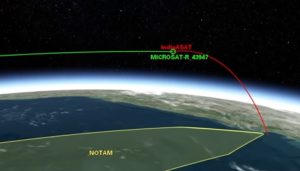
Analytical Graphics, Inc.
Last week, India conducted a successful test of its new Anti-Satellite (ASAT) missile system. This makes India the fourth nation to possess — and test — anti-satellite capability, behind the U.S., Russia and China.
“India has made an unprecedented achievement today,” said Indian Prime Minister Narendra Modi in statement shortly after the successful test. “India registered its name as a space power.”
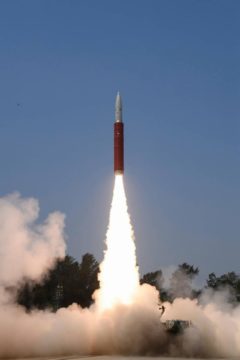
DRDO
Dubbed Mission Shakti ("power" in Hindi), the three-stage Ballistic Missile Defense (BMD) Interceptor, consisting of two solid motors plus an impactor, was developed and operated by India's Defense Research and Development Organization (DRDO). The missile employs a Kinetic Kill Vehicle to strike and shatter the target satellite.
DRDO is separate from the Indian Space Research Organization (ISRO), India's equivalent to NASA, and is similar to the U.S. Defense Advanced Research Projects Agency (DARPA).
The missile launched from the a test range off the Odisha coast at 5:39 Universal Time (UT) on Wednesday, March 27th. It struck the 1,630-pound (740-kilogram) MicroSat R at an altitude of 270 kilometers (170 miles) as it crossed northward over the Bay of Bengal.
The test comes just weeks after tensions between Pakistan and India along the disputed Kashmir border led to a brief shooting exchange in late February 2019, with aircraft shot down on both sides. India notified Pakistan of the test as per treaty and published a NOTAM (Notice to Airmen) for the hazard zone prior to launch.
The satellite's destruction created debris along its polar retrograde orbit, inclined 96.7° with respect to the Earth's equator. Satellite trackers online noticed early on that the position of India's MicroSat R matched up as the likely target for the test.
"DRDO has now confirmed it was Microsat R," says Jonathan McDowell (Harvard-Smithsonian Center for Astrophysics) who also tracks space launches worldwide. "The analysis that led us to conclude that was 99% certain, anyway."
India launched Microsat R in January 2019 as an Earth-observation satellite. It's now suspected in the satellite-tracking community that it either failed early in its mission or its use as a potential target for an ASAT test was planned from the beginning.
The U.S. Combined Space Operation Command published the first 57 tracking elements for the test's debris on April 5th, under NORAD ID 2019-006A. The Command notes on its Space-Track website that “U.S. Strategic Command's Joint Force Space Component Command (JFSCC) is actively tracking more than 250 pieces of debris associated with an Indian ASAT launch.”
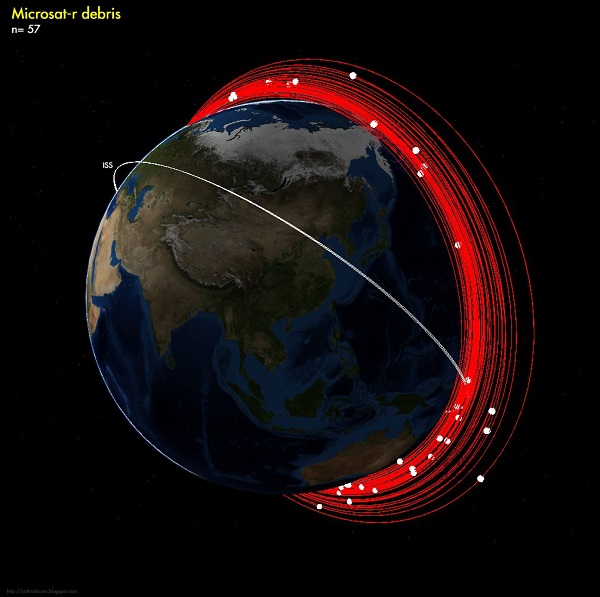
Marco Langbroek
The U.S. turned off its American “Space Fence” tracking sites in 2013, though it maintains satellite-tracking capability though sites worldwide using the Space Surveillance Network. The new Space Fence network based on Kwajalein Atoll is expected to come online later this year. Assets worldwide, including MCAT based on Ascension Island, are also dedicated to optically tracking space debris.
Some have speculated that a NOTAM that India published in February hinted at failed anti-satellite test; DRDO sources deny the claim, stating that the February launch was actually a successful trial launch of a ballistic missile defense.
NASA Responds
Most of the debris generated by the test is expected to re-enter over the coming weeks. However, some of the fragments could prove troublesome for satellites in low-Earth orbit and astronauts aboard the International Space Station (ISS). NASA Administrator Jim Bridenstine addressed a question on the issue from Patrick Murphy (NASA-Space Technology Mission Directorate) during a Town Hall meeting on Monday, April 1st.
“We have identified 400 pieces of debris from that one orbital event,” said Bridenstine. “What we are tracking right now, objects big enough to track — we are talking about 10 centimeters or bigger — about 60 pieces have been tracked . . . Of those 60, we know that 24 of them are going above the apogee [400 kilometers] of the International Space Station.”
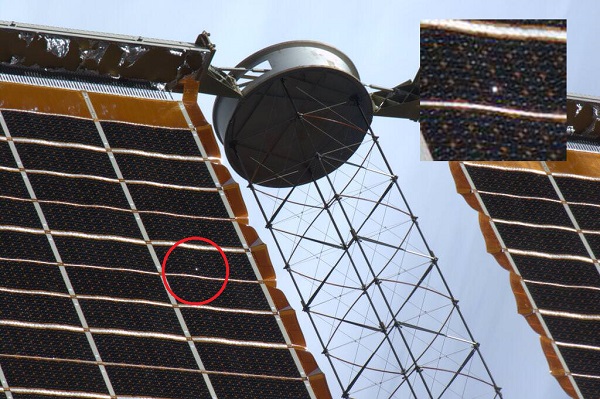
NASA
The ISS is no stranger to space debris: Astronauts aboard the station have documented holes created by debris in the station's solar panels in the past. The station also performs periodic Debris Avoidance Maneuvers, using engines on spacecraft docked to the station, to nudge the ISS out of harm's way. Crew members have even ridden out close debris passes in the Soyuz capsules, ready to head back to Earth immediately if need be.

This event comes at a bad time in terms of solar activity. During periods of high solar activity, Earth's upper atmosphere puffs out, creating additional drag that pulls on debris and satellites in low-Earth orbit. But we're headed towards a minimum in solar solar activity, so some of this high-flying debris could stay in orbit for years to come.
China carried out another notorious anti-satellite test in 2007, which added thousands of pieces of debris to low-Earth orbit and generated international outcry. (It has conducted subsequent anti-satellite tests without generating debris.) This event was also at a much higher altitude than the Indian ASAT test, at about 800 kilometers.
The U.S. also shot down its failed classified satellite USA 193 on February 21, 2008, rather than let the hydrazine-fueled mission come down on its own, potentially over populated areas. Dubbed Operation Burnt Frost, the intercept occurred at an altitude of just over 250 kilometers, slightly lower than the recent Indian ASAT test. Most of the debris from this event reentered shortly afterwards.
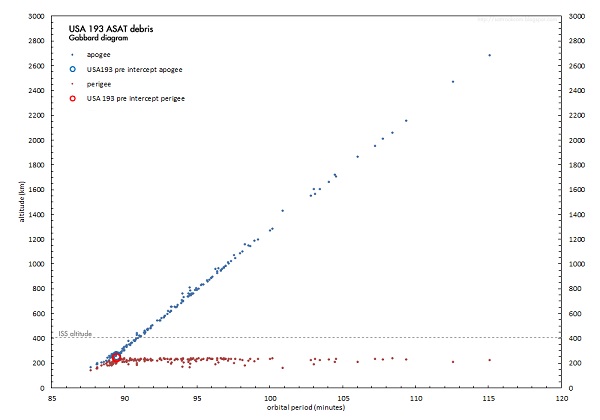
Marco Langbroek
The U.S. tested its own variant of an anti-satellite missile back in the 1980s: the ASM 135, which was launched from a U.S. Air Force F-15C Eagle.
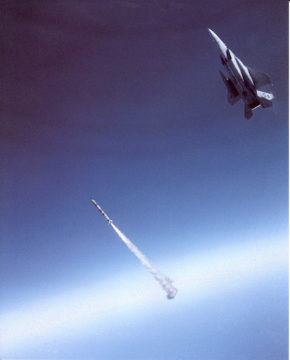
USAF
Many pundits fear that debris in low-Earth orbit could reach a tipping point, known as an ablation cascade, (also dubbed the Kessler Effect) where debris from one impact could trigger a chain reaction of additional impacts. This was famously depicted in the movie Gravity. There are ideas to clean up junk in low-Earth orbit using everything from giant nets to lasers, but this technology is still a decade or so off.
The prospect of adding thousands of small wafer-sized microsats to orbit — as SpaceX and other companies have proposed — may also compound the problem.
For now, we'll wait and see how fallout from the ASAT debris — both physical and political — unfolds.
 6
6








Comments
John
April 5, 2019 at 5:19 pm
Great, now we have more junk in orbit to mess up my astro-photos...
You must be logged in to post a comment.
Jim-Gasser
April 5, 2019 at 9:28 pm
It is disappointing that a nation with enough scientific capability to do something like this, would do it. India shouldn't do it, USA shouldn't, China shouldn't. Wait until an astronaut or astronauts get killed. They willingly take the risks, sure, but adding to the risk with this senseless behaviour is hard to fathom. "India is now a space power". Right. Power is different than being a leader.
You must be logged in to post a comment.
Anthony Barreiro
April 6, 2019 at 5:44 pm
Satellites and space debris do not stay within the borders of the nation that launched them. Earth orbit is a global resource, and anybody who launches something into space is morally bound to make sure that their stuff doesn't damage anybody else's stuff. International law holds a nation liable for damages caused by its activities in space to the assets of another state. The United States, the Russian Federation, and the European Union have laws or policies forbidding the intentional creation of space debris. The United Nations should adopt a convention explicitly forbidding signatories from intentionally creating space debris, and all spacefaring nations should sign it. It's a shame that we need to pass a law against pissing in the punchbowl, but apparently we do.
You must be logged in to post a comment.
Dobsonite
April 6, 2019 at 6:10 pm
Maybe I'm old-fashioned, but the idea of India spending the kind of billions this takes, while half it's population don't have a flush toilet is appalling. I Wouldn't it be nice if India and Pakistan could just bury the hatchet, so each wouldn't have to show the other (and the world) how "pussiant" they were, and put that money where it's needed most?
I'm all for science that advances human knowledge, health and well-being, better living standards, etc, but these kinds of outlays of money to show off are obscene given the condition of a great deal of the populace. It's mad.
You must be logged in to post a comment.
Anthony Barreiro
April 6, 2019 at 9:28 pm
Those of us who live in glass houses shouldn't throw stones. The United States spends more on our military than the next ten countries combined (China, Saudi Arabia*, Russia, India, United Kingdom, France, Japan, Germany, South Korea, Brazil). One third of the US population lives in poverty, our infrastructure is crumbling, our health care system is a disgrace, and college graduates are saddled with a lifetime of student loan debt.
* Saudi Arabia's 82.9 billion US dollars in military spending should really be added to the United States' 643.3 billion (2018 figures), because Saudi Arabia buys all their arms from the US and serves as a US proxy in the middle east.
You must be logged in to post a comment.
Haneystation
April 9, 2019 at 11:41 am
Actually I think a better depiction of Kessler effect was shown on Pixar's Wall-E.
You must be logged in to post a comment.
You must be logged in to post a comment.